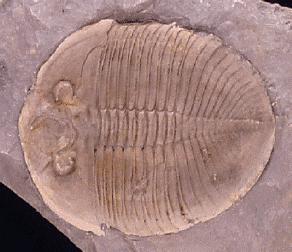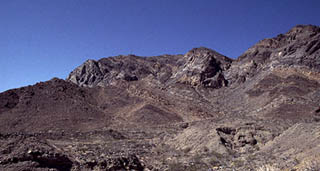Friday, January 26, 2007
Friday 1/26/07
What was done?- We continued the Geologic Time Line project.
What was collected? - Nothing.
What was assigned?- Bring textbook on Monday.
- Geologic Time Line is due Monday.
- Chapter 6 Test is Tuesday.
Daily Science Fact
 Click on this image to view an enlarged version!
Click on this image to view an enlarged version!
Among famous groups of extinct organisms, trilobites probably rank second only to the dinosaurs in fame. Their fossils are instantly recognizable and often strikingly beautiful. In fact, prehistoric people liked them as much as we do. At Arcy-sur-Cure in France, a 15,000-year- old human settlement, one of the artifacts found by archeologists was a trilobite that had been drilled to be worn as an amulet. Although the last few trilobites went extinct about 245 million years ago, they are one of the best-known and most-studied groups of fossil arthropods.
Thursday 1/25/07
What was done?- We started the Geologic Timeline Project.
What was collected? - Nothing.
What was assigned?- Bring textbook on Monday
- Chapter 6 Test is Tuesday.
Daily Science Fact

Along the California-Nevada border north of Death Valley,
the White Mountains, the Inyo Mountains, and associated ranges present one of the most important and best-known Late Proterozoic to Cambrian sections in the United States. Starting with the unfossiliferous Precambrian rocks of the Wyman Formation, paleontologists can work their way through a complete section that documents the appearance of various animals and protists, starting about 540 million years ago. Precambrian, Cambrian, and later Paleozoic rocks are also exposed to the south of the White-Inyo region, in Death Valley and in various ranges of the Mojave Desert.
Wednesday, January 24, 2007
Wednesday 1/24/07
What was done?- We did and corrected workbook pages 58-62.
What was collected? - Section 6-4 Review worksheet.
What was assigned?- Bring textbook on Friday.
Daily Science Fact

The Marble Mountains are a rather small mountain range located in one of the harshest, driest parts of the Mojave Desert, in southeastern California near the tiny towns of Chambless and Cadiz. What makes the Marble Mountains especially attractive to paleontologists is the comparatively rich Cambrian fossil biota which can be found in a particular rock layer, the Latham Shale, that is well-exposed in the southern part of the range, as well as in some nearby ranges such as the Bristol Mountains. The Latham Shale and the rock layers below and above it comprise a well-studied section of Lower and Middle Cambrian strata, which extends, with some variation, over a large part of the southern Mojave Desert.
Tuesday, January 23, 2007
Tuesday 1/23/07
What was done?- We read p.179-181.
- Workbook p.57-58.
What was collected? - "Age of Rocks" notes with summary.
What was assigned?- Section 6-4 Review Worksheet.
Daily Science Fact
The
Cambrian Period marks an important point in the history of life on earth; it is the time when most of the major groups of animals first appear in the fossil record. This event is sometimes called the "Cambrian Explosion", because of the relatively short time over which this diversity of forms appears. It was once thought that the Cambrian rocks contained the first and oldest fossil animals, but these are now to be found in the earlier
Vendian strata.
Monday, January 22, 2007
Monday 1/22/07
What was done? - We continued notes on "Relative and Absolute Dating of Rocks".
- We discussed the importance of moon rocks.
What was collected? - Nothing.
What was assigned? - Summary of the "Age of Rocks" notes.
Daily Science Fact
With the exception of the possibility that there may be water ice at the poles of
the Moon in craters that are permanently shadowed from the Sun's rays, there is virtually no water on the Moon -not running across the surface, not in the rocks. This eliminates a whole class of rocks found on Earth, the sedimentary rocks, that are formed by deposition or precipitation in water. There are no sandstones or limestones on the Moon!
Friday 1/19/07
What was done?- We took notes on "Relative and Absolute Dating of Rocks".
What was collected? - Nothing.
What was assigned?- Nothing.
Daily Science Fact
Cobra females produce a clutch of eggs each year and usually stay nearby to guard the eggs until they hatch. The baby cobra, like all snakes, is called a hatchling. The hatchling is able to take care of itself from the start and can spread its hood and strike on the same day it hatches. A large yolk sac remains in the hatchling's stomach to give it nourishment for up to two weeks before it needs to find food on its own.
Thursday, January 18, 2007
Thursday 1/18/07
What was done?- We took the Chapter 5 test.
- Read p.169-173.
- WB p.52-54 #1-9
What was collected? - Nothing.
What was assigned?- Complete reading and WB.
Daily Science Fact
When you look at
a frog or a toad, you'll notice that it doesn't seem to have a neck. Practically speaking, this is true. Most frog and toad
species have large, protruding eyes so they can see in most directions. They can also hop around to look in another direction. But they can't turn their heads like we can, since their necks are almost non-existent.
Wednesday, January 17, 2007
Wednesday 1/17/07
What was done?- We continued with the Chapter 5 Review Packet.
What was collected? - Nothing.
What was assigned?- Study for the Chapter 5 test on Thursday.
Daily Science Fact
Sea lions don’t need to drink water—they get all the water they need from the food they eat.
Tuesday, January 16, 2007
Tuesday 1/16/07
What was done?- We started the Chapter 5 Review Packet.
- We corrected Section 5-1 questions from the packet.
What was collected? - Nothing.
What was assigned?- Study for the Chapter 5 test on Thursday.
Daily Science Fact
Although the
Galapagos Tortoises are massive animals weighing several hundred pounds (kilograms), their shells are not solid. Instead, they are made up of honeycomb structures that enclose small air chambers.
Monday, January 15, 2007
Friday 1/12/07
What was done?- We did and corrected Section 5-3 review worksheet.
- We finished "Evolution: The Evidence" powerpoint notes.
- We finished"Great Transformations".
What was collected? - Nothing.
What was assigned?- Nothing.
Daily Science Fact
"Survival of the fittest" means that the strong succeed, and the weak fail, right? Well, often that's how it's portrayed, but the real story is a bit trickier. Sometimes, the story is about the "
survival of the sneakiest".
Thursday 1/11/07
What was done?- We did and corrected the Chapter 5 review worksheet.
- We worked on Section 5-3 workbook pages.
- We continued "Great Transformations" and "Evolution: The Evidence" notes.
What was collected? - Nothing.
What was assigned?- Nothing.
Daily Science Fact
Drinking too much water can be dangerous and even lead to death.
Wednesday 1/10/07
What was done?- We worked on Section 5-2 workbook pages.
- We started "Evolution: The Evidence" powerpoint notes.
- We started "Great Transformations"- a presentation about evidence for evolution.
What was collected? - Mr. Kang checked p. 44-45 in the workbook.
What was assigned?- Nothing.
Daily Science Fact
Cloudy apple juice is better for you than the clear varieties, according to Polish scientists. Eating whole apples offers more health benefits as you get the fibers in the fruit.
Tuesday, January 09, 2007
Tuesday 1/9/07
What was done?- We worked on workbook p. 49 - 51.
- We read p. 147 - 150.
- We started WB p. 44 - 45.
- We corrected WB p. 49 - 51.
What was collected? - BrainPop "Types of Rocks" & "Fossils" notes.
What was assigned?- WB check is tomorrow.
Daily Science Fact
If you happen to have an accident with super-glue, a little bit of acetone nail-polish remover helps to unglue fingers.
Monday, January 08, 2007
Monday 1/8/07
What was done?- Read p. 162 - 168 (Fossils).
- Workbook p. 49 - 51.
- Picture notes: Types of Rocks & Fossils.
What was collected? - Nothing.
What was assigned?- Color & write captions for picture notes.
- Work on WB p. 49 - 51.
Daily Science Fact
The earliest known ancestor of modern-day birds took to the skies by
gliding from trees using primitive feathered wings on their arms and legs, according to new research by a University of Calgary paleontologist.
© Mr. Kang 2005 - Powered for Blogger by Blogger Templates
 Click on this image to view an enlarged version!
Click on this image to view an enlarged version!
